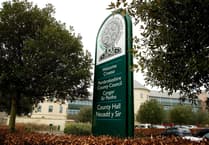Council tax in Pembrokeshire could rise by nearly 21%, adding nearly £300 to the average bill.
Members of Pembrokeshire County Council’s Cabinet, meeting on February 12, are asked to recommend one of three options for a council tax increase, ranging 16.31 per cent, 18.94 per cent, and an eye-watering 20.98 per cent increase.
These increases would increase the annual council tax rate by £219.02, £254.34, and £281.73 respectively to the average Band D property.
Pembrokeshire is currently facing a projected funding gap of £31.9m, partly due to a lower-than-expected Provisional Local Government Settlement.
That figure has increased from £27.1m in December, and £28.4m in January, when it was described as “by far the highest funding gap in our history,” by Cabinet Member for Corporate Finance Cllr Alec Cormack.
Pembrokeshire currently has the lowest basic Band D Council Tax in Wales, at £1,342.86 a year for 2023-’24, compared to Ceredigion’s £1,553.60 and Carmarthenshire’s £1,490.97, despite having increases of 12.5 per cent, 9.92 per cent, five per cent, 3.75 per cent, five per cent and 7.5 per cent since 2018-19.
The latest proposed increases would see the basic part of those bills rise to £1,561.98, £1597.30, and £1,624.69 respectively.
The final council tax bill for residents would be higher than this as town and community council precepts and the police precept would be added; with second home-owners and empty property owners facing even higher bills as both have a premium rate.
The premium rate on second homes for the next financial year is 200 per cent, effectively a treble rate, with a more complicated approach on empty properties of 100 per cent after 24 months, 200 per cent after 36 months, and 300 per cent after five years.
It is proposed to use of 85 per cent of the second homes premiums and 100 per cent of empty properties to fund the budget.
In a report before Cabinet members, the three general council tax options are outlined, with warnings that challenging cuts to council expenditure would still have to be made, even with these huge increases.
It says it would take a Band D Council Tax increase of an astronomical 42.4 per cent to bridge the projected funding gap without the use of council tax premiums, any budget savings or use of reserves.
The highest rate, 20.98 per cent, would require £9.3m of budget savings, and £0.2m of reserves, the report adding: “This will be challenging with high level of impact to service delivery, including, but not limited to, the loss of 19.3 non-school staff (including contact centre staff), one per cent reduction of school budgets (26.0 school staff) closure of two older persons day centres, reduced library opening hours and an increase in a number of fees and charges.”
The 18.94 per cent option would require £10.9m of budget savings, and £0.6m of reserves.
“This will result in more significant impact to service delivery, including, but not limited to, the savings above plus a reduction of routine highway maintenance, closure of two learning disability Day Centres, closure of St David’s waste and recycling centre, reduction in music and sport Pembrokeshire budgets, reduction of the events budget, review of Holly House provision and the loss of a further 13.4 non-school staff and 0.2 school staff.”
The lesser increase, 16.31 per cent, would require £12.8m of budget savings, and the use of £0.6m of reserves.
“This will result in more significant impact to service delivery, to include, but not limited to, the savings above plus a further one per cent reduction in school budgets (to two per cent) further reduction in highway and bridge maintenance, move to four weekly residual waste collection, complete closure of all adult care older person’s day centres and further reduction of 15.3 support service staff.”
The report said any lower council tax increases would have a “very significant impact, including statutory failure in some service areas, and so is not considered to be a financially sustainable option”.
One small glimmer of hope in the council budget is an announcement today, February 7, is a £25m consequential allocation for Welsh local authorities, which the Cabinet report hopes could ease financial pressure to the tune of some £1m.
The extra funding will form part of the Welsh Government’s Final Budget proposals, which will be published on February 27.
The final decision on the council tax level will be made by full council when it sets the annual budget on March 7.
Neighbouring Ceredigion is being recommended to increase its council tax by 13.9 per cent, with the final decision there made on February 29.
Responding to Pembrokeshire Council proposing a council tax rise of between 16% and 25%, Sam Rowlands MS, Shadow Minister for Local Government, said: “The Labour Welsh Government has to accept its share of the blame for these potential rises, which will compound misery for hard-pressed residents.
“Thanks to the Labour Government’s stale funding formula, councils are in too many cases being forced to balance their budgets on the backs of residents.
“The Welsh Conservatives would reform the funding formula to fund councils fairly, and require councils to hold a local referendum if they want to raise rates by more than 5%.”




